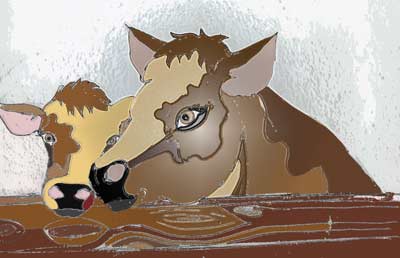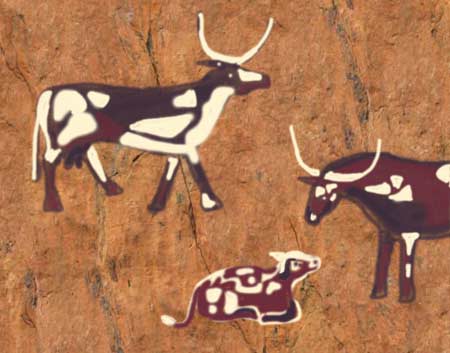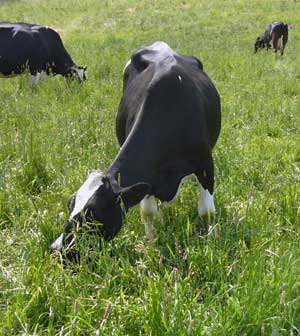Lactose Intolerance
Myths About Lactose Intolerance:
Myth: If I bloat, cramp and am gassy after meals I must be lactose intolerance
Truth: Bloating, gas, cramps and diarrhea can be caused by several different disorders. Some people who think they are lactose intolerant are actually fructose intolerant (fructose malabsorption) or have another condition that irritates the digestive tract, such as Celiac's disease, Crohns or Irritable Bowel Syndrome (IBS).
Myth: If I am diagnosed as lactose intolerant I can't eat any dairy.
Truth: Lactose intolerant people can usually tolerate small servings of dairy. Studies show that most lactose intolerant people can tolerate up to 12 grams of lactose (about 1 cup of milk) a day. However, this varies from person to person. Many people do better if they divide the lactose consumption up throughout the day. Lactose is also easier to digest if consumed with a meal. In addition, some dairy products, such as whey isolates or aged cheese, contain little or no lactose.
What is lactose intolerance?
People who are lactose intolerant lack the enzymes needed to digest dairy sugar, lactose. Lactose is a disaccharide. This means it is made out of two simple sugars, glucose and galactose, bonded together. Normally, the small intestine makes a enzyme, lactase, that splits lactose into glucose and galactose. The small intestine has portals that take up glucose and galactose and use them for energy. Lactose itself cannot be taken up into the body.
People who are lactose intolerant either don't make enough of the enzyme, lactase, or have digestion problems, such as Crohns or Celiac disease, that prevent them from digesting nutrients properly.
 Picture: "Mom, my sister called me lactose intolerant!"
Picture: "Mom, my sister called me lactose intolerant!"
Lactose or any other sugar that remains undigested in the small intestine moves into the large intestine. The microorganisms found in the large intestine eat the sugar and produce a medley of different gasses including methane. The accumulation of these gases causes bloating, cramping and noxious emissions (a nice name for smelly farts). At the same time, any sugar not consumed by the microbes attracts water into the gut. This can cause diarrhea. Symptom are normally noticeable 1/2-2 hours after eating foods high in lactose.
Who is lactose intolerant?
Almost all babies and small children can digest lactose (which is also found in human breast milk). Many adults worldwide show a decrease in lactase production as they grow older (Pribila et al. 2000). This varies widely depending on ethnic group, however. Only 5% of people from from Northern Europe show lactose intolerance compared to 90% for some Asian and African countries (Bulhões et al. 2007).
In the United States, self-reported lactose intolerance is 12%. This varies depending on their ethnic group with 10% of Hispanic Americans, 19% of Black Americans and 8% of European Americans reporting that they are sensitive to lactose (National Dairy Council 2009). Some people have lactose malabsorption (meaning that they have low lactase enzyme activity in the intestine) but don't show any symptoms of lactose intolerance. Other people have fructose intolerance which they or their doctors misdiagnose as lactose intolerance.
Why can some adults consume lactose?
Some ethnic groups have developed mutations that allows them to consume lactose throughout their lives. This is called lactase persistence. Groups that retain the ability to digest lactose into adulthood include some African tribes, most herding and nomad groups, and Northern Europeans.
These ethnic groups consumed a lot of dairy and adapted to it by continuing to produce the enzyme lactase. Interestingly, the mutation for lactose tolerance occurred independently in these different groups. Thus there are at least 5 different mutations that allow adults to consume lactose.
Interesting fact:
 The ability to digest lactose first evolved in central Europe 7,500 years ago (Itan et al. 2009). In Europeans, a single genetic mutation (13,810*T) is responsible for lactose persistence. Most European lactose tolerant people carry this modified gene. This gene quickly spread to Northern Europe. Early Northern Europeans begin making tasty cheeses soon after (Salque et al. 2012).
The ability to digest lactose first evolved in central Europe 7,500 years ago (Itan et al. 2009). In Europeans, a single genetic mutation (13,810*T) is responsible for lactose persistence. Most European lactose tolerant people carry this modified gene. This gene quickly spread to Northern Europe. Early Northern Europeans begin making tasty cheeses soon after (Salque et al. 2012).
Similarly, humans in Saharan Africa started raising cattle for milk nearly 7,000 years ago (Dunne et al 2012). They left evidence of their taste for dairy in their pots (which contain dairy fatty acids) and their gorgeous rock art. Saharan rock art contains many pictures of cattle and even a few of people milking cows. It is believed that when the climate became drier people become more nomadic and started raising animals for milk. There are 4 known lactose persistence genes present in Africa. Other mutations likely exist.
Lactose content of dairy products (source USDA database):
In general fermented dairy products contain less lactose. Also full fat dairy products contain less lactose than low fat or no fat versions. Click here to compare the lactose content of different dairy products.
Can lactose intolerance be treated?
When people eat dairy products it helps them adapt to lactose (Pribila et al. 2000). If you don't consume dairy products your body will stop making the enzymes needed to digest lactose. To readjust your body to lactose, start by consuming small amounts of dairy products such as yogurt or milk (1/4-1/2 cup) 1-3 times a day. This will normally prompt your body to start making the enzyme lactase again. As your body adjusts you can add more dairy to your diet. Most people can increase the amount of dairy they can eat without side effects.
What should I do if I am lactose intolerant?
- If you want to consume dairy products, try to build up your tolerance to lactose by very gradually increasing your consumption of dairy foods. Research shows that people may adapt to lactose consumption and have fewer or no symptoms IF they start consuming more dairy products (Pribila et al. 2000). WARNING: do this slowly so you don't have a massive intestinal gas attack. I had one friend who would avoid all dairy including cheese and then break down and consume a quart of chocolate ice cream in one night. Needless to say, he was in intense pain after his chocolate pigouts.
- Drink small quantities of milk at one time. Many people can tolerate 1/2 cup milk 1-3 times a day. Drink milk with meals. You can also try lactose free milk.
- Try full fat Greek yogurt with live probiotics. Many lactose intolerant people tolerate yogurt better than milk. It is believed that the live probiotics in yogurt may help digest excess lactose. Active bacteria in yogurt may also continue to digest lactose in the digestive tract (Kolars et al. 1984). Full fat or regular versions of yogurts have less lactose than low-fat versions. In addition, Greek yogurt is lower in lactose than regular yogurt.
- Lactose free whey, whey protein isolate or ultra-purified whey contains all the proteins of whey with little or no lactose.
- Eat lower lactose dairy products like aged cheeses.
- Remember: products other than dairy can contain lactose! Read labels to check for lactose.
- Check out my page on fructose malabsorption to see if you are sensitive to fructose. Some people are misdiagnosed with lactose intolerance when they really can't take up fructose.
Four Fun Lactose Facts:
- Lactose is a natural sugar that does not contribute to tooth decay.
- Lactose can be used a food by beneficial bacteria in the gut. It is a prebiotic.
- Lactose has a low glycemic index compared to other sugars.
- Lactose may add your body in digesting minerals like calcium.
References:
Bulhões, AC, Goldani HAS, Oliveira FS, Matte US, Mazzuca RB, Silveira, TR. Correlation between lactose absorption and the C/T-13910 and G/A-22018 mutations of the lactase-phlorizin hydrolase (LCT) gene in adult-type hypolactasia. Brazilian Journal of Medical and Biological Research. 2007;40:1441–6. Pubmed. Full text. Dunne J, Evershed RP, Salque M, Cramp L, Bruni S, Ryan K, Biagetti S, di Lernia S. First dairying in green Saharan Africa in the fifth millennium bc. Nature. 2012;486. Pubmed. Itan Y, Powell A, Beaumont MA, Burger J, Thomas MG. The Origins of Lactase Persistence in Europe. PLoS Computational Biology, 2009;5:e1000491. Pubmed. doi: 10.1371/journal.pcbi.1000491 (full paper) Kolars JC, Levitt MD, Aouji M, Savaiano DA: Yogurt – an autodigesting source of lactose. N Engl J Med 1984;310:1-3. Pubmed. National Dairy Council. Lactose Intolerance Rates May Be Significantly Lower Than Previously Believed. ScienceDaily. 6 Nov.2009. ScienceDaily. Pribila, BA; Hertzler, SR; Martin, BR; Weaver, CM; Savaiano, DA. Improved lactose digestion and intolerance among African-American adolescent girls fed a dairy-rich diet. Journal of the American Dietetic Association. 2000;100:524–8. Pubmed. Salque M, Bogucki PI, Pyzel J, Sobkowiak-Tabaka I, Grygiel R, Szmyt M, Evershed RP. Earliest evidence for cheese making in the sixth millennium bc in northern Europe. Nature. 2012; Pubmed. doi: 10.1038/nature11698

